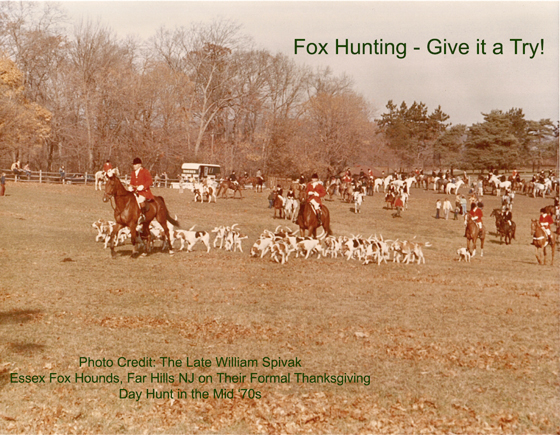Fox Hunting - Give it a Try!
by Jeannette Orr
Looking for something different to do with your horse? Why not try fox hunting?
Fox hunting began in England, with the purpose of ridding foxes from the farmers’ lands. Foxes were pests, eating small livestock like chickens and ducks. Because England does not have the rabies virus, foxes were extremely plentiful, and were a nuisance. Fox hunting came to America with the colonists. George Washington was an avid foxhunter, and spent much time perfecting the breeding of his hound pack.
The foxhunting that is done today is really “fox chasing”. Foxes are no longer killed, because they are not the nuisance that they used to be. The sport of riding to the hounds is purely for fun, and to watch the hounds work in finding their quarry. There are two types of hunting; live quarry and drag hunting.
Live quarry means that the hounds are hunting a live fox. The huntsman will cast the hounds in an area known as a “covert” looking for fox. If the hounds find a fox, they will “speak” and if the scent is strong, off they go!
A drag hunt is the laying of an artificial scent, and the scent is “dragged” by one of the hunt staff. The hounds are cast onto the existing scent, and the chase is on. Drag hunting does not chase a live fox. This method is now used in areas that are more populated. It is easier to control where the hounds go by using a drag scent.
In the hunt field, there is staff that hunts the hounds. The Huntsman is in charge of the hounds, and casts them to find a scent, and will call them back to him. This is done with voice commands and with different blows on a hunting horn. The Huntsman is assisted by the Whippers-In, aka “whips”. The Whips are the assistants, and will ride out ahead of and to the side of the Huntsman to keep the hounds from straying or going off on an errant scent, like a deer. There are usually 2-3 Whips assisting. The Field Master is in charge of all of the riders who are hunting. The Field Master will set the pace, and all field members must stay behind the Field Master.
Sound intriguing? I enjoy hunting because I get to ride in beautiful country. I love watching the hounds work to find their quarry, and I enjoy the relationship that the Huntsman has with his hounds. If you are interested in trying fox hunting, you may participate in a hunt by paying a “capping fee”. This varies by Hunt but is usually around $50 for cubbing season, which is August through September, and $75 for open season hunting. Capping allows prospective members to try hunting without having become a member of the hunt. New hunters will “hilltop” which means you will ride with a separate Field Master and will stay well behind the field. Riding at a distance for newbies is recommended, both to see how your horse will react and how you will enjoy hunting.
Hunting has been traditionally ridden in hunt seat tack and attire, but some hunts are now allowing Western riders to hunt as well. Their only requirement is that you must wear an ASTM approved helmet. So don’t let the fact that you are a Western rider stop you! You will see people in proper hunt attire, but the rules on attire have become more relaxed. Hunts are now more focused on having members than worrying about what they wear!
Hunting is physically demanding on both you are your horse. You will be out from 2 to 4 hours on a hunt. Both you are your horse must be fit enough to gallop some distances, and to go up and down hills and through water. Most jumps do have go arounds, so jumping is not required, but some in some territories you may have to jump a log fence or a coop.
A good way to see what hunting territory is like is to participate in a hunter pace event. This event is a timed competition over hunting terrain. A team goes out and sets the pace for the ride, which is called the “ideal time”. This time is kept a secret. Teams of riders then go out and try to guess the pace. In hunting, you will gallop, walk, trot and be at a halt. The winners are the ones who come closest to the ideal time, not the ones who ride the course the fastest. Hunter paces will give you a sense of what the terrain is like that you would be hunting in.
For more information, go to www.mfha.org to find local hunts near you and to learn more about the sport of fox hunting.
Happy Hunting!



